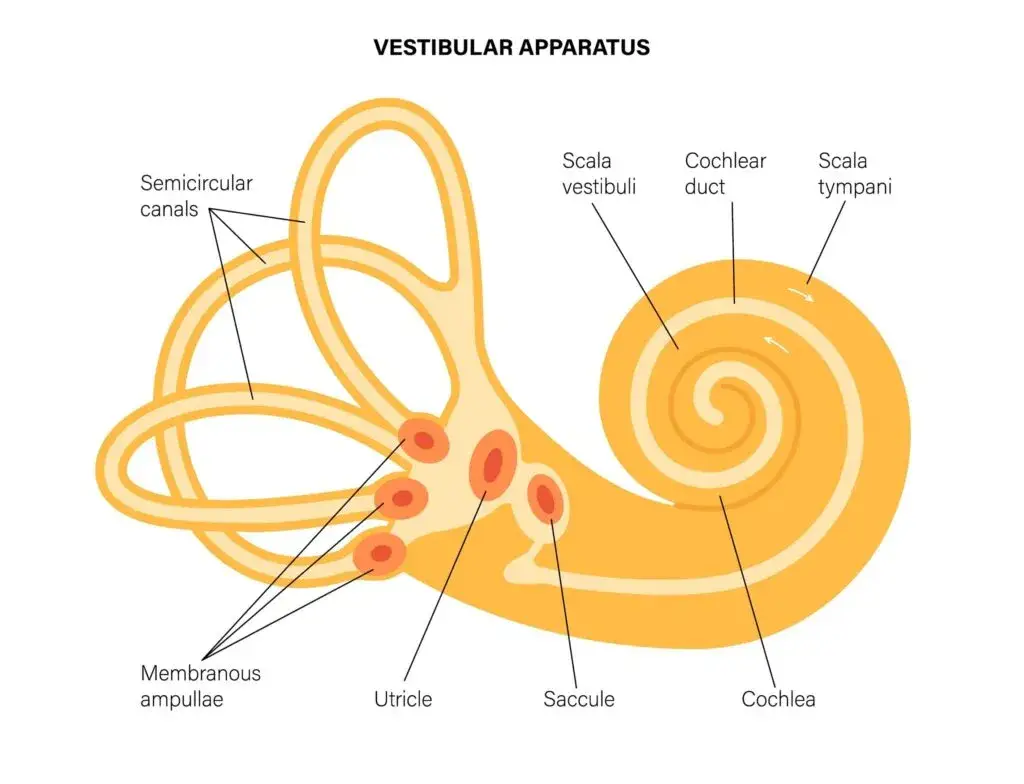
Vertigo and Motion Sickness: If you’ve ever felt the room spin after rolling over in bed—or gotten queasy reading in a moving car—you know how disorienting vestibular problems can be. Patients often ask us, “Are vertigo and motion sickness the same thing?” They share overlapping symptoms—nausea, dizziness, cold sweats, imbalance—but they’re not identical. Understanding where they differ (and where they overlap) is the first step toward the lasting relief so many people in Sarasota, Bradenton, and Lakewood Ranch are searching for.
At Lavender Family Chiropractic in Sarasota, Florida, we help patients every day who struggle with vertigo, motion sickness, Meniere’s disease, dizziness, and balance issues. Many have tried medications, home remedies, or “just dealing with it,” only to find the problem keeps coming back. What’s frequently missed? The upper cervical spine—the delicate junction where your head meets your neck—can disrupt the body’s balance and motion systems when misaligned. Restore this region’s alignment, and the body often regains the clarity and steadiness it’s been missing.
This article breaks down vertigo vs. motion sickness, explains how the upper cervical region can drive both, and outlines how our gentle, precise upper cervical chiropractic care helps people across Sarasota and Manatee counties get back to living with confidence—without popping, twisting, or cracking.
Vertigo vs. Motion Sickness: What’s the Difference?
- Vertigo is a false sensation of movement. You might feel like you or your surroundings are spinning, tilting, swaying, or pulling—even while you’re perfectly still. Vertigo can last seconds or hours, and it’s often accompanied by imbalance, nausea, ear fullness, or ringing (tinnitus).
- Motion sickness is a real movement problem—the brain receives conflicting signals from your eyes, inner ear (vestibular system), and body. For example, your inner ear senses the car is moving, but your eyes are fixed on a stationary book. That mismatch can trigger nausea, dizziness, cold sweats, and fatigue.
Bottom line: They’re not the same, but they overlap. People with vertigo often have heightened motion sensitivity and get carsick or seasick more easily. Likewise, people who get motion sick repeatedly may be dealing with a vestibular system that’s already stressed—sometimes because the upper neck is misaligned and sending distorted position/balance signals to the brain.
A Quick Tour of Your Balance System (and Why It Matters)
Your sense of balance is a team effort among three systems:
- Vestibular system (inner ear): Tiny canals filled with fluid detect acceleration and head rotations; otolith organs sense linear motion and gravity.
- Vision: Your eyes help confirm whether you’re moving, how fast, and in what direction.
- Proprioception: Nerves in muscles and joints—especially in the neck—tell the brain where your body parts are in space.
The brain integrates all three to maintain equilibrium, steady your gaze (via the vestibulo-ocular reflex, or VOR), and keep you upright. If one system goes off, the others must work overtime. If two systems send conflicting signals—say, the eyes vs. the inner ear—symptoms escalate quickly. That’s motion sickness. If inner ear or neural processing errors create a false sense of movement, that’s vertigo.
Now add one more key player: the upper cervical spine. The atlas (C1) and axis (C2) sit under your skull and surround the brainstem, a major relay hub for vestibular, visual, and proprioceptive information. When this region is misaligned—even subtly—it can distort proprioceptive input, irritate brainstem pathways, and alter how your body integrates balance signals. The result: vertigo, dizziness, and motion sensitivity that won’t go away.
How the Upper Cervical Region Can Create Vertigo and Motion Sickness
Think of the upper neck as a high-precision tripod under a camera (your head). If one leg shifts, the lens loses focus. In your body, that “out of focus” feeling shows up as dizziness, imbalance, or nausea. Here are key mechanisms at play:
- Proprioceptive distortion: Muscles and joints in the upper neck are loaded with sensors. A misalignment can change how those sensors fire, confusing your brain’s map of head position. When proprioception conflicts with inner ear and visual input, you feel dizzy—and on a moving vehicle, you may get motion sick fast.
- Brainstem irritation: The atlas and axis cradle the lower brainstem. Misalignments may increase mechanical stress or tension, which can sensitize vestibular pathways and the trigeminocervical complex—a hub involved in head/neck sensation and head–eye coordination.
- VOR instability: If the brain isn’t fully confident about where the head is in space, eye-stabilization reflexes can misfire, leading to blurred vision with movement, visual motion sensitivity, and motion-triggered nausea.
- Fluid and circulation dynamics: Subtle changes in head-neck alignment can influence venous drainage and cerebrospinal fluid dynamics. While everyone’s physiology differs, many patients report fewer “pressure” and fullness sensations as alignment improves.
The punchline: you can chase symptoms with medications or patches, but if the upper cervical misalignment remains, the body keeps sending mixed signals. Correct the misalignment, and you often correct the confusion.
Common Vertigo-Related Diagnoses and Where Motion Sickness Fits In
- BPPV (Benign Paroxysmal Positional Vertigo): Brief spinning triggered by head movements (rolling in bed, looking up). Often due to tiny calcium crystals (“ear rocks”) shifting into a semicircular canal. Many BPPV patients also report motion sensitivity—cars, boats, even grocery store aisles.
- Vestibular Migraine: Dizziness, imbalance, visual motion intolerance, and sometimes headaches or light/sound sensitivity. Motion (car rides, scrolling screens, busy visual environments) can be a big trigger.
- Meniere’s Disease: Episodic vertigo with fluctuating hearing loss, tinnitus, and ear fullness. Motion during an episode is especially nauseating.
- Vestibular Neuritis/Labyrinthitis: Sudden dizziness after a viral illness, often with imbalance and motion intolerance during recovery.
- PPPD (Persistent Postural-Perceptual Dizziness): Chronic dizziness and hypersensitivity to motion or complex visual environments, often following an initial vestibular event.
- MdDS (Mal de Débarquement Syndrome): Rocking/swaying sensations after boat or plane travel; motion can paradoxically feel better than stillness.
- Cervicogenic Dizziness: Dizziness believed to originate from cervical spine dysfunction—frequently made worse by head/neck movement and improved with targeted cervical interventions.
Across these conditions, upper cervical alignment is the common denominator we evaluate. When the atlas/axis are corrected gently and precisely, the nervous system often recalibrates. Patients report smoother head-eye coordination, steadier balance, and less motion sensitivity.
Why Do Some People Get Motion Sickness from Vertigo?
When your vestibular system is irritated or miscalibrated (e.g., BPPV, vestibular migraine, cervicogenic dizziness), it becomes hypersensitive to movement. Even routine car rides or screen scrolling can set off nausea and cold sweats. An upper cervical misalignment can keep the system in this irritated loop by continuously sending distorted position data. That’s why people say, “I used to be fine, and now I can’t ride in the back seat without getting sick.” Fix the loop at its source, and your tolerance for motion frequently returns.
The Lavender Family Chiropractic Difference
We’ve built our Sarasota clinic around one guiding principle: Measure precisely, adjust gently, and let the body’s design do the healing. Here’s how that looks in practice.
Advanced 3D CBCT Imaging
We utilize state-of-the-art 3D CBCT scans of the upper cervical spine to visualize the atlas/axis in remarkable detail. This lets us identify even minute misalignments—exactly where they are, how they’re angled, and the safest, most effective path to correct them. No guesswork.
Functional Nervous System Scans (Tytron)
We use paraspinal infrared thermography to assess autonomic nerve function along the spine. This helps us see how misalignments may be affecting communication between brain and body—and how your nervous system responds as care progresses.
Gentle, Precise Adjustments—No Popping, Twisting, or Cracking
Our upper cervical chiropractic adjustments are low-force and extremely specific. Patients are often surprised by how comfortable they are. Realignment is about precision, not force. When done right, the body relaxes and re-balances.
Stabilization and Follow-Through
Alignment is step one; stability is the goal. We’ll check leg-length balance, posture, and thermography markers, and we’ll teach you simple home strategies to protect your correction so results last.
A Three-Doctor Team Committed to Your Success
Our care is delivered by Dr. Rusty Lavender, Dr. Jacob Temple, and Dr. Will Guzinski—a team uniquely focused on resolving complex vestibular and balance complaints with upper cervical methods. Together, we’ve helped thousands of people in Sarasota and Manatee counties get back to driving, boating, traveling, and simply living without fear of dizziness.
Who We Help (and the Results Patients Report)
We see people who’ve tried everything—from anti-nausea meds and meclizine to repeated canalith maneuvers—only to have symptoms recur. After upper cervical care, patients commonly report:
- Less spinning or swaying, especially with position changes
- Better tolerance for car rides, boats, and flights
- Reduced sensitivity to busy visual environments (stores, crowds)
- Fewer “bad days” with Meniere’s-type fullness or ringing
- Clearer thinking and less brain fog
- Improved posture and confidence with movement
Our clinic serves Sarasota, Bradenton, Lakewood Ranch, Parrish, Ellenton, Venice, Osprey, Punta Gorda, St. Petersburg, Siesta Key, Longboat Key, Lido Key, and Myakka City—and many patients drive from even farther because they want a chiropractor Sarasota Florida residents trust for vertigo and dizziness.
When to Get Help (and Red Flags You Shouldn’t Ignore)
Most vertigo and motion-sickness patterns are benign but miserable. However, seek urgent medical care for symptoms like: sudden severe headache, double vision, trouble speaking/swallowing, face droop, limb weakness/numbness, chest pain, or fainting. For persistent or recurrent dizziness without red flags, upper cervical evaluation is a smart next step—especially if symptoms flare after neck strain, concussion, whiplash, or long hours at a desk.
Self-Care Tips While You’re Healing
These won’t “fix” an upper cervical misalignment, but they can reduce symptom flare-ups as your body recalibrates:
- During travel: Face forward, pick a seat with the smoothest ride (front seat in cars, mid-ship on boats, over the wing on planes), and look toward the horizon rather than reading up close.
- Screen hygiene: Take frequent visual breaks; reduce rapid scrolling.
- Sleep and stress: Consistent sleep and stress-reduction calm a sensitive nervous system.
- Gentle movement: Short walks, light neck mobility within comfort, and relaxed breathing can help.
- Hydration and regular meals: Avoid heavy, greasy foods pre-travel; small, frequent meals are often better tolerated.
As upper cervical alignment stabilizes, most people find they can reintroduce previously provocative activities (reading in the car, amusement rides, longer flights) with far fewer issues.
What to Expect as a New Patient at Lavender Family Chiropractic
- Consultation and History
We listen. When did symptoms start? What makes them worse? Any concussions, car accidents, or chiropractic history? What have you already tried? - Targeted Testing
Postural analysis, Tytron nerve scans, and often 3D CBCT imaging to pinpoint misalignment vectors in your upper neck. If BPPV is suspected, we’ll discuss appropriate positioning strategies and collaborate as needed. - Individualized Plan
We craft a plan to correct and stabilize your alignment. Adjustments are gentle and specific. We’ll map an expected cadence for visits and reevaluations so you know what to expect. - Progress Monitoring
We re-measure—thermography, posture, and function—to make sure your body is truly stabilizing. Most patients see meaningful changes early; others steadily improve week by week. - Long-Term Confidence
As your corrections hold longer, visit frequency typically decreases. Our goal is durable change, not endless adjustments.
Why Local SEO Matters for Finding the Right Help
If you searched for “chiropractor near me,” “upper cervical chiropractor near me,” “Vertigo doctor near me,” “Migraine doctor near me,” or “chiropractor Sarasota Florida,” you’re probably overwhelmed by options. Upper cervical work is a subspecialty focused on atlas/axis alignment with advanced imaging and precision protocols. If dizziness, vertigo, or motion intolerance is your primary complaint, it’s essential to choose a clinic—like Lavender Family Chiropractic—that emphasizes upper cervical chiropractic with 3D CBCT and Tytron scanning and a gentle, no popping/twisting/cracking approach.
Patient Snapshots (Names Changed for Privacy)
- “Susan,” 62, Lakewood Ranch: Avoided boating for years due to “instant queasiness.” CBCT revealed a rotational atlas misalignment. After a series of gentle upper cervical corrections, she returned to weekly cruises on the bay—without dramamine.
- “Derek,” 38, Sarasota: Desk-bound software engineer with intermittent vertigo and nausea scrolling on his phone. Postural asymmetries and Tytron findings pointed to upper cervical stress. With correction and workstation tweaks, his motion sensitivity resolved.
- “Maria,” 55, Bradenton: Meniere’s-type flares for a decade. After customized upper cervical care, episodes became infrequent and milder; she now flies to see her grandkids confidently.
While every story is unique, the common thread is this: when the upper cervical spine is corrected and stabilized, the brain gets clear, consistent information—and life opens back up.
Top 15 FAQs: Vertigo, Motion Sickness, and Upper Cervical Care
- Are vertigo and motion sickness the same thing?
No. Vertigo is a false sense of movement; motion sickness is your brain’s response to real movement it can’t reconcile. They often overlap. - Why do I feel dizzy even when I’m still?
That’s classic vertigo. Your balance networks are sending the brain confusing signals—often involving the inner ear and neck proprioception. - Can an upper cervical misalignment really cause motion sickness?
It can contribute. Distorted neck input can clash with visual/inner-ear information and heighten motion sensitivity. - What is BPPV and how is it different from other vertigo?
BPPV is brief spinning with head movements due to displaced inner-ear crystals. Other causes (vestibular migraine, cervicogenic dizziness, Meniere’s) have different mechanisms and timelines. - How does upper cervical care help Meniere’s, dizziness, and balance issues?
By restoring atlas/axis alignment, the nervous system often integrates balance information more cleanly. Patients commonly report fewer and less intense episodes. - What makes your approach different from standard chiropractic?
We specialize in upper cervical chiropractic using 3D CBCT and Tytron to guide gentle, precise adjustments—no popping, twisting, or cracking. - Will I need to be adjusted at every visit forever?
No. We focus on correction and stability. As your alignment holds, visit frequency typically decreases. - How quickly will I notice changes?
Some feel shifts immediately; others improve steadily over several weeks as the nervous system recalibrates. - Do you coordinate with other providers?
Yes. When helpful, we collaborate with ENTs, vestibular therapists, or primary care to support comprehensive recovery. - Can kids get vertigo or motion sickness?
Yes. We offer gentle pediatric-appropriate assessments and care when indicated. - Is the adjustment painful?
No. Our techniques are low-force and highly specific. Patients are often surprised by how comfortable they are. - What about screens and scrolling—why do they make me queasy?
Busy visual input can overstimulate a sensitive VOR. As alignment stabilizes, visual motion tolerance typically improves. - What if I’ve had whiplash or a concussion?
Head/neck injuries often involve the upper cervical spine. Correcting that region frequently helps persistent dizziness or motion sensitivity. - Do you take insurance?
Our office is out of network with insurance. Many of our patients receive a superbill to submit to their insurance for reimbursement based on their coverage. We offer many different payment options as well as finance options. - How do I get started?
Schedule a consultation. We’ll review your history, perform targeted scans, and—if appropriate—take 3D CBCT images to design a plan.
Your Next Step: Get to the Root Cause
If vertigo, motion sickness, Meniere’s disease, dizziness, or balance issues are dictating your plans—canceling boat days, skipping flights, avoiding car rides—there is a better way. Upper cervical chiropractic focuses precisely where your balance and motion systems converge. When alignment is restored and stabilized, the brain can trust the signals it receives—and you can trust your body again.
Lavender Family Chiropractic in Sarasota Florida offers complimentary consultations to learn more about you. Click the link below!
https://intake.chirohd.com/new-patient-scheduling/724/lavender-family-chiropractic
Visit our Website!
To learn more about us go to http://www.chiropractorsarasotaflorida.com
We also service Bradenton, Parrish, Ellenton, Ruskin, Venice, Tampa, St. Pete, Osprey, Longboat, Lakewood Ranch, Myakka City.
If you are in Tampa, Fort Myers, or Salt Lake City, you can visit my other locations! NeckWise Upper Cervical. Visit, www.neckwise.com
If you are not local, visit www.uccnearme.com to find a doctor in your area.
Lavender Family Chiropractic proudly serves Sarasota, Bradenton, Lakewood Ranch, Parrish, Ellenton, Venice, Osprey, Punta Gorda, St. Petersburg, Siesta Key, Longboat Key, Lido Key, and Myakka City.
- Address: 5899 Whitfield Ave Ste 107, Sarasota, FL 34243
- Website: www.chiropractorsarasotaflorida.com
- Phone: (941) 243-3729
- Instagram: @lavenderfamilysrq • TikTok: @drrustylavender
When you’re searching for “chiropractor near me,” “upper cervical chiropractor near me,” “Vertigo doctor near me,” “Migraine doctor near me,” or “chiropractor Sarasota Florida,” remember: the most important thing isn’t a quick fix—it’s a precise, gentle correction that lasts.
We’d be honored to help you find your balance again.





